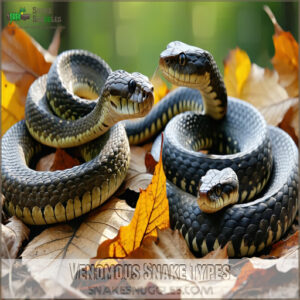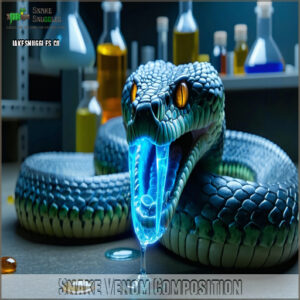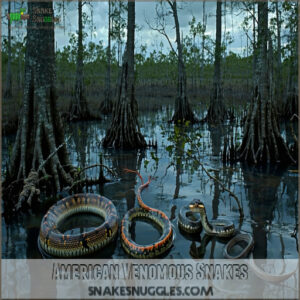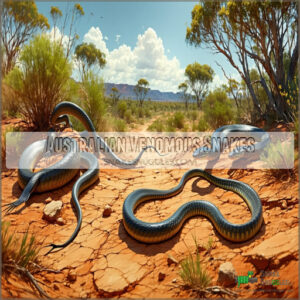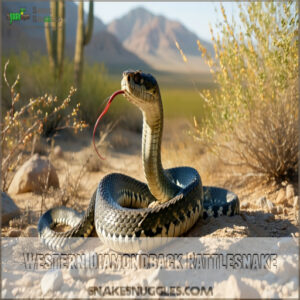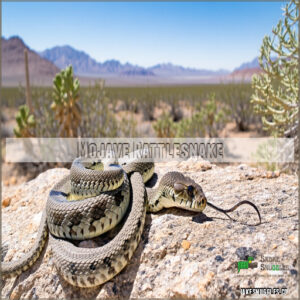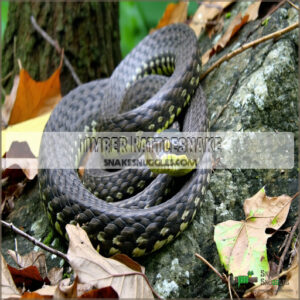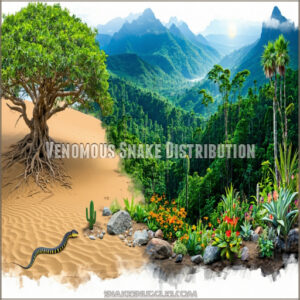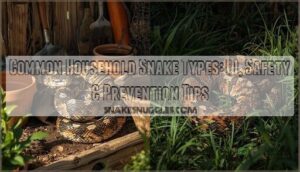This site is supported by our readers. We may earn a commission, at no cost to you, if you purchase through links.
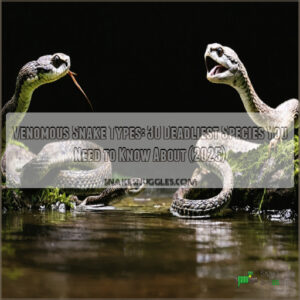 You’ll find four main venomous snake types in North America that demand your attention.
You’ll find four main venomous snake types in North America that demand your attention.
Rattlesnakes, nature’s own alarm system, pack heat-sensing pits and that famous tail warning. Copperheads prefer to lurk near water and rocky spots, while cottonmouths showcase their stark white mouths when threatened.
Don’t let the coral snake’s beautiful bands fool you – their neurotoxic venom packs a delayed but dangerous punch.
With roughly 7,000 bites reported annually, knowing these serpents’ signatures isn’t just fascinating – it’s essential for your safety. Understanding their unique hunting tactics and preferred hideouts might just save your life.
Table Of Contents
- Key Takeaways
- Venomous Snake Types
- Snake Venom Composition
- Global Venomous Snakes
- North American Venomous Snakes
- Venomous Snake Distribution
- Frequently Asked Questions (FAQs)
- What is the top 10 most venomous snake?
- What are the 4 venomous snakes in the US?
- What is the 1 deadliest snake?
- Which snake venom is most toxic?
- How long can venomous snakes live in captivity?
- What colors do baby venomous snakes have?
- Can venomous snakes be safely kept as pets?
- Do venomous snakes hibernate during winter months?
- How far can different venomous snakes strike?
- Conclusion
Key Takeaways
- You’ll encounter four main venomous snakes in North America: rattlesnakes with their heat-sensing pits and warning rattle, copperheads that prefer water and rocky areas, cottonmouths known for displaying their white mouths when threatened, and coral snakes with their neurotoxic venom.
- You’re looking at approximately 7,000 venomous snake bites annually in the US, making it crucial to recognize their distinctive features – from the rattlesnake’s folding fangs and hemotoxic venom to the coral snake’s delayed but potent neurotoxic effects.
- You’ll need to watch for specific habitats: copperheads on forest floors and near water sources, cottonmouths in semi-aquatic environments, rattlesnakes in various terrains from deserts to forests, and coral snakes hiding under logs and leaves.
- You’re safe in Alaska, Hawaii, Maine, and Rhode Island as they’re the only US states without venomous snakes, while all other states have at least one species of these serpents, though fatalities remain low at 5-10 annually.
Venomous Snake Types
You’ll find four main types of venomous snakes in North America: rattlesnakes (Crotalus), copperheads (Agkistrodon contortrix), cottonmouths (Agkistrodon piscivorous), and coral snakes (Micrurus).
While these serpents aren’t out to get you, it’s important to understand their characteristics, as approximately 7,000 people receive venomous snake bites in the United States each year, which is a significant reason to be aware of the complete concepts of snake behavior.
Rattlesnakes Characteristics
Rattlesnakes’ distinctive characteristics set them apart as North America’s most recognizable pit vipers.
These venomous snakes possess heat-sensing pits between their eyes and nostrils, helping them detect prey with remarkable precision.
- Their iconic rattle consists of interlocking keratin segments that create a warning buzz
- Most species average 3-5 feet in length, with some reaching 8 feet
- They’re equipped with folding fangs that rotate forward during strikes
- Their venom contains hemotoxins that destroy tissue and blood cells
- They showcase remarkable snake camouflage patterns matching their habitats
Rattlesnakes play an essential role in maintaining ecological balance through their rattlesnake facts and unique hunting strategies.
Copperheads Habitat
While exploring forest floors across the eastern United States, you’ll find copperheads perfectly camouflaged among fallen leaves.
These venomous snakes prefer diverse habitats near water sources and rocky outcrops.
You’ll often spot them in copperhead dens during winter months, where they brumate in groups.
| Habitat Type | Key Features | Common Locations |
|---|---|---|
| Forest Floors | Leaf litter, logs | Eastern woodlands |
| Rocky Areas | Crevices, outcrops | Appalachian region |
| Wetlands | Stream edges, swamps | Coastal plains |
| Urban Areas | Gardens, woodpiles | Suburban zones |
| Mixed Terrain | Brush, fallen trees | Mountain foothills |
The table outlines the various habitats where copperheads can be found, including forest floors, rocky areas, wetlands, urban areas, and mixed terrain.
Cottonmouths Behavior
When you encounter a cottonmouth in its natural habitat, you’ll notice its distinctive defensive display.
These semi-aquatic predators aren’t typically aggressive, but they’ll stand their ground when threatened.
You’ll see them coil up, display their white mouth lining, and vibrate their tail.
Their hunting tactics combine ambush predation with active foraging, making them highly adaptable in both aquatic and terrestrial environments, using a unique blend of hunting tactics.
Coral Snakes Venom
While cottonmouths defend their territory aggressively, coral snakes take a different approach with their potent venom.
These shy reptiles pack a powerful neurotoxic punch that’s unlike other North American snake venom types.
Here’s what makes coral snake venom unique:
- Contains powerful neurotoxins that block nerve signals
- Requires prolonged contact for effective venom delivery
- Causes minimal initial pain but progressive paralysis
- Shows delayed onset of symptoms, making early treatment essential
You’ll find these elusive snakes hiding under logs and leaves, preferring to avoid confrontation despite their lethal capabilities.
Snake Venom Composition
You’ll find snake venom is a complex mixture of proteins and enzymes that work together to immobilize prey and aid in digestion.
Each snake species has its own unique venom composition, which scientists measure using the LD50 scale to determine toxicity levels, and this is crucial for understanding the toxicity levels.
LD50 Measurement
The measurement of snake venom toxicity, known as LD50 (median lethal dose), reveals how deadly a serpent’s bite can be.
Scientists determine LD50 values through four distinct injection methods: subcutaneous, intravenous, intramuscular, and intraperitoneal.
While all provide insights into venom potency, subcutaneous tests best mirror real-world snake bites.
If you encounter a snake, the Humane Society offers guidance.
Mouse studies typically form the basis for these essential toxicity measurements.
Venom Toxicity Levels
Understanding venom toxicity levels helps you gauge the potential danger of different snake species.
The Inland Taipan claims the title of world’s most venomous snake, with an LD50 of 0.025 mg/kg.
Here’s how venom potency ranks globally:
- The Eastern Diamondback Rattlesnake ranks 23rd in toxicity among venomous snakes
- The Saw-scaled Viper causes the most human deaths worldwide
- The Dubois’ Sea Snake holds second place for venom potency
Learning about venomous snake species can help you better understand the risks associated with them.
Venom Delivery Systems
Looking beyond toxicity levels, a snake’s venom delivery system determines its lethal potential.
Pit vipers showcase advanced fang structures that fold back when not in use, while coral snakes possess fixed, shorter fangs.
The venom flow through specialized ducts combines with precise bite force to inject toxic doses effectively, and you’ll find that different venomous snakes have evolved unique delivery mechanisms to maximize their venom’s impact.
This unique adaptation allows snakes to efficiently deliver their venom, making them formidable predators, with a highly effective venom delivery system.
Global Venomous Snakes
You’ll find deadly venomous snakes across four major regions: Africa’s black mambas and puff adders, Asia’s kraits and cobras, America’s rattlesnakes and coral snakes, and Australia’s taipans and brown snakes.
While these serpents command respect with their potent venom systems and specialized hunting adaptations, you’ll be glad to know that only 200 of the world’s 3,700 snake species pose a significant risk to humans, which is due to their venomous nature and the fact that they are deadly.
African Venomous Snakes
From the swift Black Mamba to the aggressive Saw-Scaled Viper, Africa’s venomous snake types are both fascinating and deadly.
The Puff Adder’s widespread range makes it a leading cause of bites, while the Boomslang’s potent venom is rarely encountered.
Each species, including the Carpet Viper, showcases unique adaptations, emphasizing the need for caution in their habitats, with the Puff Adder being a notable example.
Asian Venomous Snakes
Asia is home to some of the deadliest species, like Russell’s viper and the saw-scaled viper, both infamous for high fatalities.
These venomous snake types deliver potent venom, causing severe snakebite symptoms. Proper venomous snake identification is essential for safety.
Their venom, a mix of neurotoxins and hemotoxins, demands rapid venom extraction to prevent complications. Always exercise caution in viper habitats.
American Venomous Snakes
American venomous snakes include rattlesnakes, copperheads, cottonmouths, and coral snakes, each with distinct venom effects and behaviors.
Rattlesnake species like the Mojave and Eastern Diamondback are particularly dangerous, while copperheads rely on camouflage.
Cottonmouths, often found in wetlands, display defensive postures.
Snake bites from these species are rare but serious, highlighting the importance of snake conservation and awareness of venomous snake types.
Australian Venomous Snakes
Australia is home to some of the world’s deadliest snakes, including the inland taipan, coastal taipan, eastern brown snake, and mainland tiger snake.
The inland taipan, with the lowest LD50, is the most venomous globally.
Learn about venomous snake characteristics to understand their potent toxins.
The eastern brown snake causes most fatalities, while the coastal taipan and death adder deliver rapid, lethal strikes.
Always respect their habitats!
North American Venomous Snakes
North America is home to a diverse array of venomous snakes, including rattlesnakes, copperheads, cottonmouths, and coral snakes, each with unique adaptations and potent venoms.
Understanding their habitats, behaviors, and distinguishing traits is essential for both safety and appreciating their ecological roles, which involves recognizing the importance of venomous snakes in the ecosystem.
Eastern Diamondback Rattlesnake
The Eastern Diamondback Rattlesnake, a heavyweight among venomous snake types, is the largest rattlesnake species.
As a pit viper, it showcases distinctive diamond patterns and thrives in southeastern U.S. habitats.
Known for its potent venom, this rattlesnake’s behavior includes ambush hunting and defensive rattling.
Venom research aids snake conservation, emphasizing its ecological role and the importance of understanding rattlesnake diet and reproduction.
Western Diamondback Rattlesnake
The Western diamondback rattlesnake, a pit viper on the venomous snake list, grows 4-6 feet and thrives in arid habitats like deserts and grasslands.
Known for its distinct rattle and defensive behavior, this snake species delivers potent venom effects through its fangs.
Snake conservation efforts highlight its role in controlling rodent populations, though snake bites demand swift medical attention.
Mojave Rattlesnake
The Mojave rattlesnake, a pit viper, thrives in arid Mojave habitats across the southwestern U.S.
Known for its potent snake venom, it impacts both the nervous system and bloodstream, making it one of the most dangerous venomous snake types.
With its distinctive rattlesnake behavior, this desert survival expert warns intruders with a rattle before a potentially deadly rattlesnake bite.
Timber Rattlesnake
From the Mojave’s desert domain, let’s explore the Timber Rattlesnake, a pit viper thriving in the dense forests of the eastern United States.
Known for its adaptability, this venomous snake plays an important role in forest dynamics.
- Habitat: Found in rugged terrain and hardwood forests.
- Behavior: Ambush predator with calm temperament.
- Conservation: Threatened by habitat loss and human activity.
Venomous Snake Distribution
You’ll find venomous snakes on nearly every continent, with their distribution influenced by climate, habitat, and prey availability.
From the deserts of the southwestern United States to the rainforests of South America, these reptiles adapt to diverse ecosystems, shaping their survival strategies.
US States With Venomous Snakes
Every state except Alaska, Hawaii, Maine, and Rhode Island has venomous snakes, making the U.S. a hotspot for snake-infested areas.
From rattlesnakes to coral snakes, the list of venomous species varies regionally.
Snakebite risks remain low, with only 5-10 fatalities annually.
To avoid deadly encounters, stay alert in high-risk areas and learn about regional dangers, using a reliable snake identification tool, and understanding a snake identification guide is important for recognizing venomous species and taking necessary precautions to prevent bites.
Snake Habitats and Environments
Understanding snake habitats helps you appreciate their role in ecosystems.
Venomous snakes thrive in diverse environments, each customized to their survival needs:
- Desert Ecosystems: Home to species like sidewinders.
- Forest Floors: Shelters copperheads with excellent camouflage.
- Wetland Areas: Cottonmouths dominate these swampy regions.
- Rocky Outcrops: Timber rattlesnakes prefer rugged terrain.
- Grasslands: Rattlesnakes often bask here.
Protecting these habitats supports snake conservation and balances snake ecology.
Researchers study snake habitat products to better understand venomous species.
Human Snake Encounters
Human encounters with venomous snakes often occur in habitats like forests, swamps, or rocky areas.
While most snakes avoid humans, accidental interactions can happen.
Recognizing venom effects quickly is critical for snake bite treatment.
Emergency response and bite prevention are essential for human safety.
Having a complete snake bite kit is important in such situations.
| Encounter Type | Location | Snake Species |
|---|---|---|
| Hiking Accidents | Forested Trails | Copperheads, Rattlesnakes |
| Aquatic Proximity | Swamps, Streams | Cottonmouths |
| Yard Intrusions | Suburban Areas | Coral Snakes |
Snakebite Prevention Methods
After close encounters with venomous snakes, you’ll want solid prevention strategies.
For effective snake bite prevention, wear thick boots and long pants when exploring snake-prone areas.
Keep your yard clear of debris, and use a flashlight during nighttime walks. Stay on marked trails, and if you spot a snake, maintain several feet of distance.
Remember: most snakes would rather avoid you than bite. Understanding snake bite prevention measures is paramount to minimizing the risk of encounters with venomous species, and following these tips can help ensure a safe and enjoyable experience in snake-prone areas with venomous species.
Frequently Asked Questions (FAQs)
What is the top 10 most venomous snake?
While you’d think rattlesnakes top the list, the Inland Taipan leads with its lethal venom, followed by Eastern Brown Snake, Black Mamba, Tiger Snake, and Death Adder’s lightning-fast strike.
They’re nature’s deadly elite.
What are the 4 venomous snakes in the US?
You’ll find four dangerous serpents in the US: rattlesnakes, copperheads, cottonmouths (water moccasins), and coral snakes.
Each belongs to either the Viperidae family or, in coral snakes’ case, the Elapidae family.
What is the 1 deadliest snake?
The Inland Taipan (Oxyuranus microlepidotus) contains the world’s deadliest venom, with an LD50 of 025 mg/kg. You’ll rarely encounter this shy Australian snake, which prefers to avoid human contact.
Which snake venom is most toxic?
Like a drop of liquid death, you’ll want to steer clear of the Inland Taipan’s venom – it’s the world’s most toxic, with an LD50 of 025 mg/kg.
Requiring immediate medical attention is crucial due to the venom’s potency, making the Inland Taipan a highly toxic species.
How long can venomous snakes live in captivity?
Most venomous snakes you’ll keep as pets can survive 15-20 years when properly cared for. You’ll find species like cobras reaching 20-25 years, while some pythons can live beyond 30 years.
What colors do baby venomous snakes have?
Baby rattlesnakes, copperheads, and coral snakes display vibrant patterns for camouflage. You’ll notice their colors are often brighter than adults, with distinct bands or spots that’ll fade as they mature.
Can venomous snakes be safely kept as pets?
Playing with fire isn’t wise – you shouldn’t keep venomous snakes as pets.
They’re strictly regulated, require special permits, and even experienced handlers can’t guarantee safety.
Contact your local herpetological society for guidance.
Do venomous snakes hibernate during winter months?
During winter, you’ll find most snakes in a state called brumation – it’s not true hibernation, but they’ll slow down and shelter in dens when temperatures drop below 60°F (16°C).
How far can different venomous snakes strike?
You’d be surprised – most venomous snakes can strike about half their body length.
The black mamba reaches 8-12 feet, striking up to 6 feet away, while rattlesnakes typically strike within 2-3 feet.
Conclusion
Ready to face the wild with confidence? Your newfound knowledge of venomous snake types equips you with essential survival skills.
From the rattlesnake’s warning buzz to the coral snake’s deceptive beauty, understanding these creatures’ behaviors and habitats is essential.
Remember, respect for these remarkable predators, combined with preventive measures, greatly reduces your risk.
While venomous snake types may seem intimidating, they’re generally more afraid of you than you’re of them, so stay alert, maintain distance, and enjoy nature safely.
- https://animal-care.com/blog/a-guide-to-identify-venomous-snakes-in-north-america/
- https://crofab.com/envenomation-education/snakes-in-your-state
- https://ufwildlife.ifas.ufl.edu/venomous_snake_identification.shtml
- https://www.nps.gov/bith/learn/nature/venomous-snakes.htm
- https://en.wikipedia.org/wiki/List_of_dangerous_snakes

